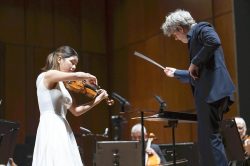
A scene from the 72nd “NHK Kohaku Uta Gassen.”
11:07 JST, February 7, 2022
A television staple on New Year’s Eve for decades that has seen steadily declining ratings, the “NHK Kohaku Uta Gassen (red-white singing battle)” has reached a crossroads. Producers had hoped that emphasizing diversity would reverse the trend.
According to Video Research Ltd., ratings for the 72nd edition of the live music show on Dec. 31 were 34.3% in the Kanto region for Part 2 of the program starting at 9 p.m. — the lowest ever since the two-part format was adopted in 1989.
Although NHK tried to innovate with a new format for the “battle” that was more in tune with the times, it failed to draw more viewers.
The Kohaku, in which the entertainers are divided into the male White Team and female Red Team, started on the radio in 1951. Two years later, the program was first aired also on TV, and from there its popularity took off.

In 1963 — the year before the 1964 Tokyo Olympic Games, which provided the impetus for widespread use of TVs in Japan — the ratings hit a whopping and still-standing record of 81.4%. After the split into two parts in 1989, the ratings for Part 2 remained steady in the 50s through the end of the 20th century, but continually declined in recent years.
In the 2021 broadcast, NHK implemented a number of changes. In line with growing gender awareness and the discrepancies it implies both socially and culturally, NHK stopped using the terms “White Team emcee” and “Red Team emcee,” instead referring to both as an “emcee.”
Under the theme of “colorful,” the station also launched an appeal for diversity, including awareness of “Sustainable Development Goals (SDGs)” which has been increasingly attracting public interest in recent years.
Likewise, unlike in previous years, there was none of the verbal skirmish between emcees Yo Oizumi and Haruna Kawaguchi, lessening the element of a rivalry between men and women.
Grasping for a way to attract young viewers, the show included artists popular with the younger set such as Mafumafu and Kaze Fujii, who made their debuts on the show. But because NHK Hall is undergoing renovations and the show was staged at Tokyo International Forum, a number of acts were performed live at other locations, including that by the popular girls group NiziU. While the performances were still spectacular, the show lacked a bit of the pizzazz of a live broadcast.
The appeal of Kohaku was once characterized as relying on “3 S” — sex, by separating the performers into teams by gender; sports, by making it a competition; and suspense, by leaving the outcome uncertain until the end.
This time, NHK tried to go beyond those elements, only to see a drop of 6.0 percentage points from the previous year in the ratings for Part 2. The ratings for Part 1, which started at 7:30 p.m., dropped 2.7 percentage points to 31.5%.
“In a live broadcast, there is no telling what will happen and the unexpected can occur,” NHK President Terunobu Maeda said at a regular press conference on Jan. 13. “It seems we need to produce a program which makes full use of the merits of a live broadcast.”
The Kohaku was aired simultaneously via BS4K and BS8K satellite channels and on “NHK+,” a video streaming service. Consequently, it is difficult to evaluate the show based solely on viewer ratings of the conventional terrestrial broadcast.
As the available forms of media have diversified, TV stations find themselves in an era in which few TV programs draw viewers who watch together in large groups.
“Kohaku, through television, had become a sort of homestead for the heart, where many could share the joy of watching singing performances in their living room,” said Takahiko Kageyama, professor of Doshisha Women’s College of Liberal Arts and television critic.
“I hope [NHK] works to keep continue appealing to men and women of all ages, and show the place television can have in our lives.”
"Culture" POPULAR ARTICLE
-

Van Cleef & Arpels Dazzles with Art Deco Artisanry at Tokyo Exhibit
-

Disney’s ‘Twisted-Wonderland’ Animated Series Puts Villains in Spotlight: New Show Features School Inspired by Classic Disney Films
-

Ayumi Hamasaki’s Shanghai Concert Canceled Day Before Schedule as Part of Beijing Backlash
-

‘The World Masterpiece Theater Series’ Celebrates 50 Years; Animator Looks Back on Creating Anime Classics
-

Popularity of Piggy Banks Across Time and Place Seen at Bank’s Museum of Money Boxes in Hyogo Pref.
JN ACCESS RANKING
-

Tokyo Economic Security Forum to Hold Inaugural Meeting Amid Tense Global Environment
-

Keidanren Chairman Yoshinobu Tsutsui Visits Kashiwazaki-Kariwa Nuclear Power Plant; Inspects New Emergency Safety System
-

Imports of Rare Earths from China Facing Delays, May Be Caused by Deterioration of Japan-China Relations
-

University of Tokyo Professor Discusses Japanese Economic Security in Interview Ahead of Forum
-

Japan Pulls out of Vietnam Nuclear Project, Complicating Hanoi’s Power Plans























